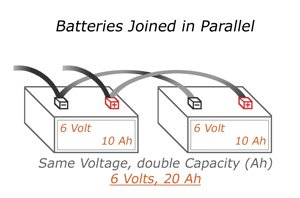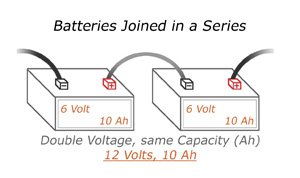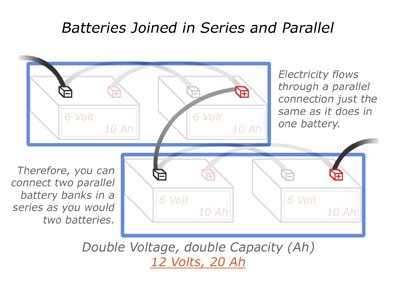We’d like to remind Forumites to please avoid political debate on the Forum.
This is to keep it a safe and useful space for MoneySaving discussions. Threads that are – or become – political in nature may be removed in line with the Forum’s rules. Thank you for your understanding.
📨 Have you signed up to the Forum's new Email Digest yet? Get a selection of trending threads sent straight to your inbox daily, weekly or monthly!
Complex Battery project HELP!
EdwardB
Posts: 462 Forumite




in Techie Stuff
Hi
I am wondering if anyone has ever done this and made it work, I got the idea because I was given a device that needs an expensive battery. The old battery said please recycle and I thought I might go a step better.
I want to create a money saving Li-ion rechargable battery pack, I can buy my battery but it costs around £40, I can get them for less why not do it myself, so I can use industry standard battery sizes or at least save money (or both)
I noticed on eBay you could buy small batteries of the same spec mAh for much less, obviously they are smaller and something tells me they would not last as well.
As I understand it, if I connect 4 of these up in a parallel then the voltage remains the same and the mAh increases (great because it means a longer time on battery right?).

and if I join them in series the mAh remains the same but the voltage increases,

I do NOT want to connect in series because it the increase in voltage would probably blow the device. OBVIOUSLY, I am going to test the final thing on a voltimeter before attaching to the device.
I see that I can also do both series and parallel

which increases both mAh and voltage but I do not want to do this.
SO, I opened up the dead battery and the four batteries DO seem to be connected in parallel, there is a strip across the top and a strip across the bottom, BUT they connect to a tiny little circuit board which may do nothing other than connect this power to the connector the device uses.
I was going to build something similar but without the circuit board, if I understood what it did I might replicate it or I might even use it but it is not easy to find batteries that if connected in parallel add up to the voltage it expects.
So what else can this circuit board be doing
The 4 cells it has are pretty big, they are indeed in parallel then they seem pretty high spec mAh, so why so big if smaller batteries can deliver the same mAh?
When I look at laptop batteries, say a 9 cell battery and the mAh it has for the size then it seems I am missing something, why are their batteries so big? Is there another factor that affects how long the charge works other than mAh? If not why would they not make them smaller?
I could desolder the existing electronics solder them to some cheap set of 4 batteries that cost £3 and see if the output voltage is the same as I expect.
Can I do away with the electronics, could it be doing anything else, smoothing the current or telling the device all is well??
Originally I was planning on creating a container that holds batteries in a parallel way and then soldering the output from that to the same as the device needs. This sort of thing but parallel not serial

When closed the container is like this

That way I can swap batteries in and out at will (must be all at same time), any issues in this?
Benefits would be that I save money and the the on/off switch.
IF you have some experience then I would appreciate your thoughts.
Credit to Battery Stuff
https://www.batterystuff.com/kb/articles/battery-articles/battery-bank-tutorial.html
Please be nice to all MoneySavers. That’s the forum motto. Remember, the prime aim is to help provide info and resources. If you don’t like someone, their situation, their question or feel they’re intruding on ‘your board’ then please bite the bullet and think of the bigger issue. :cool::)
0
Comments
-
First of all are you fully aware of the potential fire risk from Lithium batteries if you get something wrong?
On that basis....
Yes, you can join batteries in parallel in order to double the capacity and / or increase the maximum current you can safely draw. It is essential that both are at a similar charge when connected otherwise the higher one will charge the other, possibly at an unsafe rate. The same can happen if one goes faulty in some way and could potentially put an excessive load on the good battery.
Depending on the battery pack you have the circuitry may be to regulate the charging or this may be done by the external charger. You need to be certain as it is vital that Lithium batteries are charged correctly and not allowed to go over voltage. Most packs will also contain some kind of thermal and current protection. Again this is vital.
Take care and if in doubt, don't!0 -
Thanks for your reply.
I did say they must all be done at same time, I plan to test the batteries first by charging them on a conventional charger.
Any idea about the size issue and longevity?Please be nice to all MoneySavers. That’s the forum motto. Remember, the prime aim is to help provide info and resources. If you don’t like someone, their situation, their question or feel they’re intruding on ‘your board’ then please bite the bullet and think of the bigger issue. :cool::)0 -
The circuitry will be to protect the cells from over- or under-voltage conditions.
Standard 18650 cells come in two varieties -- protected and unprotected. Unprotected cells have no protection circuitry and are ideal when used in a battery pack that has its own protection/charging circuitry.
You can also get protected cells (which have the protection circuitry built-in). They are intended for use in things like torches which don't have their own protection circuitry built-in.
It is extremely dangerous to use Li-ion cells without any form of protection. If the charge drops too low and they are recharged, or if they are overcharged, they can explode.
But otherwise, you should be able to swap out the old cells to refurbish the battery.
Just make sure you're 100% sure of what you're doing first.0 -
AS said above - don't mess about with 18650 type batteries unless you know what you are doing - these things can make quite a mess a if they are charged or discharged incorrectly. I would really advise you to leave it alone, spend the few quid and get the battery pack you need.0
-
Also a note on lithium cells, particularly the 18650, LOTS of fakes out there!!!!
An 18650 should be around 2200-3600mAh, certainly no more than 3600mAh. As I mentioned there are tonnes of fake 18650 cells out there.
I bought some "Elfleland" 3800mAh and the actual capacity of these cells is 500mAh, they are basically an empty tube with a small lithium cell inside, stuffed with sand to stop it moving around (and to increase the weight).
A genuine 18650 should weight around 40g and cost upwards of £5 each.
As for your idea, I would personally go with cells in parallel and then use a boost converter circuit to get the exact voltage output required. I would probably also set up a zener diode crowbar circuit just in case the boost converter went crazy.
Remembering that with a boost converter if your output is 12v @ 1A and your input voltage is 6v, your input current is approximately 2A. Double the voltage out, double the current in.
Alternatively you can go with a higher battery voltage and bring that down with a "buck" convertor (opposite to boost converter).“I may not agree with you, but I will defend to the death your right to make an a** of yourself.”
<><><><><><><><><<><><><><><><><><><><><><> Don't forget to like and subscribe \/ \/ \/0 -
As above, last time I looked, the only suppliers of 18650 cells were Chinese brands. Mis-representing the capacity is so common that (it seems) everyone does it. Some of the more honest manufacturers/sellers even advertise things like "3000mAh cell (actually 2200mAh)"!
I don't actually know if they're the "genuine" article, and the capacity is undoubtedly exaggerated, but I've been using the UltraFire brand cells for a while and not had any problems. But maybe the concept of a "brand" in China is more akin to a label that anyone can use. Everything's a knock-off. :-/
One other thought... The existing protection/charging circuitry might be designed for cells of a particular capacity. Is it possible that the circuitry might not work properly with different capacity cells...? (I don't know enough about electronics to answer that.)0 -
As above, last time I looked, the only suppliers of 18650 cells were Chinese brands.
Best just to buy genuine Samsung 18650s (#NCR18650B) from a genuine UK seller, expect to pay £5 or more per battery. Certainly not £5 for 4 of random Chinese cells (as you see on eBay).“I may not agree with you, but I will defend to the death your right to make an a** of yourself.”
<><><><><><><><><<><><><><><><><><><><><><> Don't forget to like and subscribe \/ \/ \/0 -
Having been using 18650s for vapng for the last 4 years, I can safely say that current best value are Samsung 25R, get them from Gearbest (chinese co., well-known in vaping circles) or if you want a UK seller (other brands of battery also) (and almost double the price) look for Torchy the Battery Boy's ebay shop - he tests every type of battery before he sells them, also very good reputation in vaping (and cycle lights) circles:-
http://www.gearbest.com/18650-battery-samsung-25r-_gear/
http://www.ebay.co.uk/sch/big_f_d_d/m.html?_nkw=&_armrs=1&_ipg=&_from=......Gettin' There, Wherever There is......
I have a dodgy "i" key, so ignore spelling errors due to "i" issues, ...I blame Apple 0
0 -
^^ Which reminds me, i'd bet money that these incidents of vapes exploding into flames are caused by using poor quality 18650s.“I may not agree with you, but I will defend to the death your right to make an a** of yourself.”
<><><><><><><><><<><><><><><><><><><><><><> Don't forget to like and subscribe \/ \/ \/0 -
Strider590 wrote: »^^ Which reminds me, i'd bet money that these incidents of vapes exploding into flames are caused by using poor quality 18650s.
no, incorrect, they're usually caused by numpties carrying fully-charged "spare" batteries LOOSE IN POCKETS!!!!!! along with keys, coins, etc. There are several caused by users of mechanical mods (which have no protection circuitry, hence "mechanical") who build inappropriate coils which over-stress the battery in terms of current draw, others who forget to lock the fire button to prevent accidental firing.....for the smaller ego-style batteries using too-high charging currents and unattended charging is the most common cause - these are the ones that have caused a couple of house fires
I could go on, but it is actually very rare to be caused by the battery itself, 99.9% of the time it's by user error one way or the other......Gettin' There, Wherever There is......
I have a dodgy "i" key, so ignore spelling errors due to "i" issues, ...I blame Apple 0
0
This discussion has been closed.
Confirm your email address to Create Threads and Reply

Categories
- All Categories
- 352.3K Banking & Borrowing
- 253.6K Reduce Debt & Boost Income
- 454.3K Spending & Discounts
- 245.3K Work, Benefits & Business
- 601.1K Mortgages, Homes & Bills
- 177.6K Life & Family
- 259.2K Travel & Transport
- 1.5M Hobbies & Leisure
- 16K Discuss & Feedback
- 37.7K Read-Only Boards



